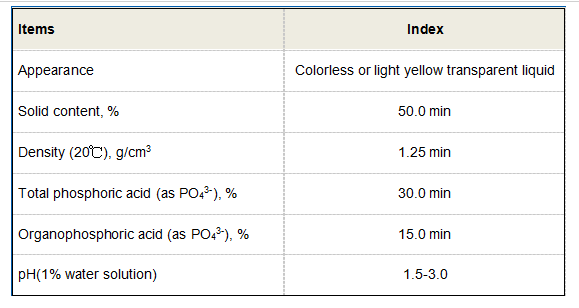ethylene diamine tetra methylene phosphonic acid
Ethylene Diamine Tetra Methylene Phosphonic Acid An Overview
Ethylene diamine tetra methylene phosphonic acid (EDTMPA) is a versatile and highly effective chemical compound widely used in various industrial and scientific applications. As a member of the phosphonate family, EDTMPA has garnered attention due to its unique properties and potential uses in fields ranging from water treatment to agriculture.
Chemical Structure and Properties
EDTMPA possesses a complex molecular structure characterized by its four methylene phosphonic acid groups attached to an ethylene diamine backbone. This structure grants EDTMPA properties such as high solubility in water, excellent chelating ability, and significant stability across a range of pH levels. The ability to form stable complexes with metal ions makes EDTMPA particularly useful in preventing scale formation and corrosion in industrial systems.
Applications in Water Treatment
One of the principal applications of EDTMPA is in the treatment of water, particularly in cooling systems and industrial processes where mineral scaling can impede efficiency. By inhibiting the crystallization of calcium and other mineral salts, EDTMPA helps maintain optimal operational conditions, thus prolonging the lifespan of equipment. The chelation process effectively binds metal ions, preventing them from precipitating and forming deposits, which can be costly to mitigate.
Furthermore, EDTMPA is utilized in the oil and gas industry to enhance the recovery of crude oil. Its properties allow it to act as a scale inhibitor, reducing the risks associated with scaling in pipelines and tanks. As oil extraction processes evolve and demand for efficient resource recovery rises, the importance of effective agents like EDTMPA continues to grow.
Utilization in Agriculture
ethylene diamine tetra methylene phosphonic acid

In agricultural applications, EDTMPA can be employed as a chelating agent for essential micronutrients. It facilitates the uptake of nutrients such as iron, zinc, and manganese in crops, enhancing their growth and yield. By forming stable complexes with these micronutrients, EDTMPA improves their solubility and availability to plants, which is particularly crucial in soils where nutrient availability is limited or in conditions often promoting nutrient leaching.
Moreover, EDTMPA's role in reducing soil and water pollution cannot be underestimated. By assisting in the effective use of fertilizers, the compound helps minimize the risk of excessive nutrient runoff into water bodies, thereby contributing to more sustainable agricultural practices.
Research and Development
Research into EDTMPA continues to grow, with ongoing studies examining its interactions with various environmental and biological systems. Scientists are particularly interested in its potential applications in biomedicine, including its use as a radiopharmaceutical agent in nuclear medicine. The ability of EDTMPA to form stable complexes with radioactive isotopes may lead to advances in imaging and therapeutic techniques.
Additionally, there is ongoing research into the degradation and environmental impact of phosphonate compounds. Understanding how EDTMPA interacts with biological systems and whether it poses any ecological risks is crucial as industries increasingly rely on such compounds.
Conclusion
Ethylene diamine tetra methylene phosphonic acid is an important chemical with widespread applications in various sectors. Its unique properties make it a valuable asset in water treatment, agriculture, and potentially in medical applications. As research expands and industries continue to innovate, the role of EDTMPA is likely to evolve further, solidifying its status as a critical component in modern chemical applications. Through understanding and utilizing EDTMPA effectively, industries can enhance efficiency, promote sustainability, and contribute to technological advancements in numerous fields.
By continuing to explore new applications and improving existing ones, EDTMPA has the potential to significantly influence environmental practices and resource management in the face of global challenges.
-
2-Phosphonobutane-1,2,4-Tricarboxylic Acid: Scale & CorrosionNewsAug.29,2025
-
Premium Isothiazolinones | Broad-Spectrum Biocidal SolutionsNewsAug.28,2025
-
LK-319 Special Scale And Corrosion Inhibitor For Steel Plants: Advanced Solutions for Industrial Water SystemsNewsAug.22,2025
-
Flocculant Water Treatment: Essential Chemical Solutions for Purification ProcessesNewsAug.22,2025
-
Isothiazolinones: Versatile Microbial Control Agents for Industrial and Consumer ApplicationsNewsAug.22,2025
-
Scale Inhibitor: Key Solutions for Water System Scale PreventionNewsAug.22,2025





